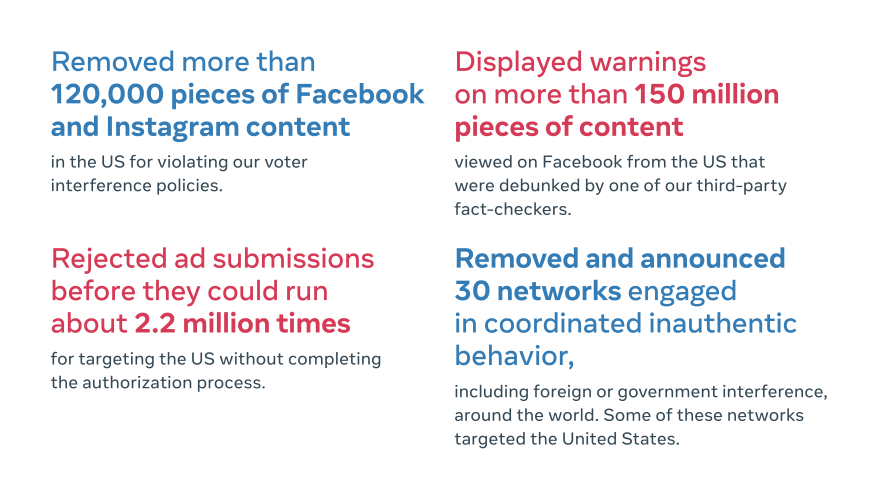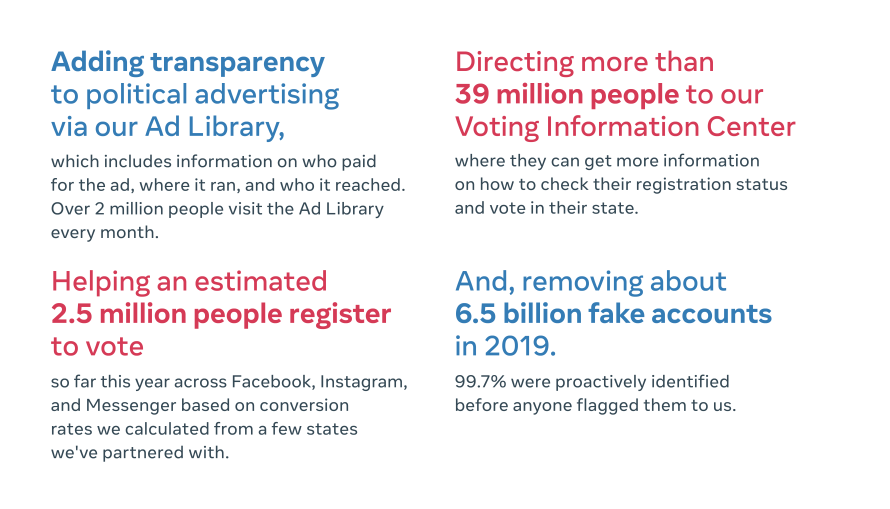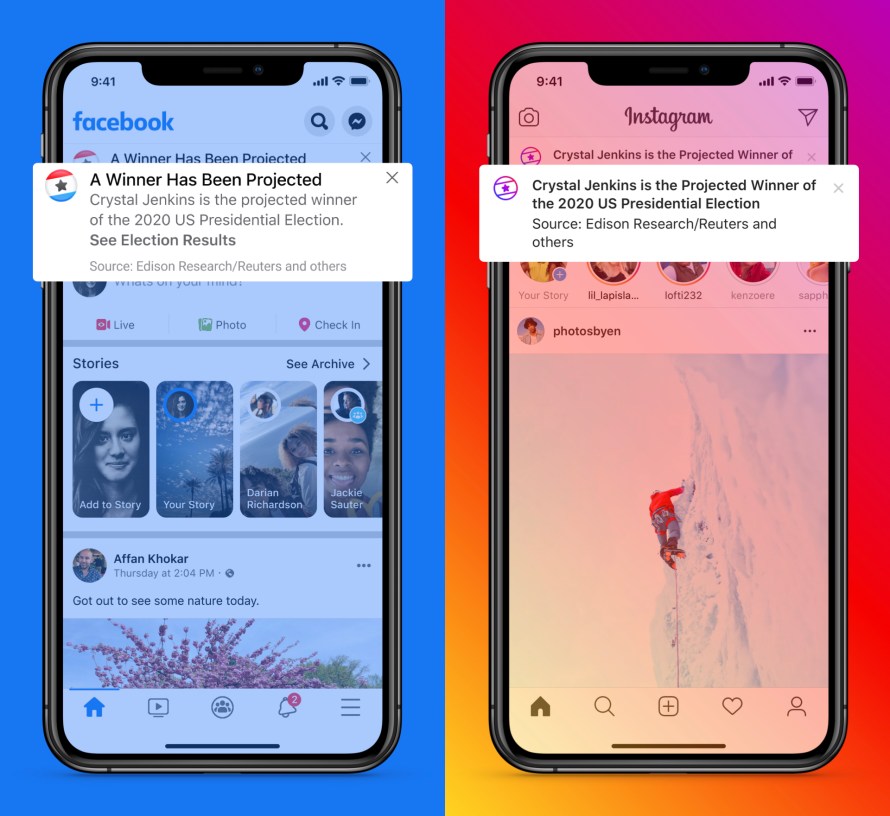We’ve known for a long time that the 2020 election in the US would be unlike any other. We’ve been preparing for this election with a unique set of products and policies. As we head into the final stretch, we remain focused on two important goals:
- Helping more Americans register and vote
- Protecting the integrity of the election by fighting foreign interference, misinformation and voter suppression
Since 2016, we’ve made substantial investments, built more teams and have worked with experts and policymakers to focus our efforts in the right places. We worked on more than 200 elections around the globe since then, learning from each, and now have more than 35,000 people across the company working on safety and security issues. As a result, we’ve made substantial progress. Between March and September of this year, for example, we have:
This is in addition to our ongoing efforts, including:
Despite this progress, we’re not taking our eye off the ball. Here are some of the ways that we’ll be working to protect the integrity of this election over these next critical weeks and making sure people have the latest authoritative information about the results.
Activating Our Elections Operations Center
In 2018, we launched our Elections Operations Center ahead of the US midterm elections. Since then, we’ve run it for major elections in Brazil, India, Europe and many other parts of the world. Through it, we bring together subject matter experts from across the company – including from our threat intelligence, data science, engineering, research, operations and legal teams – for real-time monitoring so that we can address potential abuse flowing across our network.
At the onset of the COVID-19 pandemic, we transitioned our work to a virtual space, and that remote Elections Operations Center has run for every caucus, primary, party convention and presidential debate to date, including ahead of tonight’s Vice Presidential debate, and will continue to run through the election. To prioritize our work around the threats we are seeing, our team works in pods to identify and stop suspicious activity. This includes watching for threats in the form of organic content and issue ads, proactively detecting violating content including voter suppression, and investigating attempts of foreign and domestic interference.
Since 2016, we’ve built an advanced system combining people and technology to review the billions of pieces of content that are posted to our platform every day. State-of-the-art AI systems flag content that may violate our policies, users report content to us they believe is questionable and our own teams review content.
We’ve also been building a parallel viral content review system to flag posts that may be going viral – no matter what type of content it is – as an additional safety net. This helps us catch content that our traditional systems may not pick up. We have used this tool throughout this election, and in countries around the world, to detect and review Facebook and Instagram posts that are likely to go viral and take action if that content violates our policies.
In addition, our teams are using other targeted tools to further pinpoint potentially abusive content and address emerging issues on our platform, including our Crisis Assessment Dashboard (CAD). CAD can – for example – allow us to correlate spikes in hate speech or voter interference content happening in Pages or Groups in near real-time across all 50 states. We have alerts for these spikes in signals, which route to operational teams who review the content for risk trends or potential violations, and remove it if we determine it violates our rules.
Planning for Election Results
Getting the final election results this year may take longer than previous elections due to the pandemic and more people voting by mail. So we’re preparing a range of policies and products to keep people informed and prevent the spread of misinformation.
For example, when polls close, we will run a notification at the top of Facebook and Instagram and apply labels to candidates’ posts directing people to the Voting Information Center for more information about the vote-counting process. But, if a candidate or party declares premature victory before a race is called by major media outlets, we will add more specific information in the notifications that counting is still in progress and no winner has been determined.
Note: Content and design might change as we refine the products before launch.
If the candidate that is declared the winner by major media outlets is contested by another candidate or party, we will show the name of the declared winning candidate with notifications at the top of Facebook and Instagram, as well as label posts from presidential candidates, with the declared winner’s name and a link to the Voting Information Center.
Note: Content and design might change as we refine the products before launch.
And, as we noted earlier this month, we are attaching an informational label to content that discusses issues of legitimacy of the election or claims that lawful methods of voting like mail-in ballots will lead to fraud. This label provides reliable information about the integrity of the election and voting methods. We will help people understand the process with notifications at the top of the Facebook and Instagram apps, through Facts About Voting from the Bipartisan Policy Center, and curated news in people’s News Feed and the Voting Information Center.
In addition, while ads are an important way to express voice, we plan to temporarily stop running all social issue, electoral or political ads in the US after the polls close on November 3, to reduce opportunities for confusion or abuse. We will notify advertisers when this policy is lifted.
Banning Additional Content that Seeks to Intimidate Voters
In addition to the steps that we already take to remove calls for coordinated interference at or bringing weapons to polling places, when we become aware of them, we will also remove calls for people to engage in poll watching when those calls use militarized language or suggest that the goal is to intimidate, exert control, or display power over election officials or voters. We thank the civil rights experts and community members who continue to help us understand trends in this area and we look forward to continuing to work with them.
Working with Federal and State Law Enforcement and Election Authorities to Fight Voter Interference
We also continue to coordinate with state attorneys general and other federal, state, and local law enforcement officials responsible for election protection. When they identify potential voter interference, we investigate and take action if warranted, and have established strong channels of communication to respond to any election-related threats. These efforts are part of our ongoing coordination with law enforcement and election authorities at all levels to protect the integrity of the election.
Last year, we launched Facebook Protect to offer security tools and additional protections to safeguard the Facebook and Instagram accounts of campaigns, elected officials, federal and state political party committees and staff. This has been helping to stop the hack-and-leak operations we saw in 2016. With just under a month until Election Day, we’re encouraging more people to enroll in Facebook Protect by running a notification at the top of Facebook this week to Page admins for government officials, campaigns, political parties and others.
Learn more about our efforts to help protect elections.
:




























